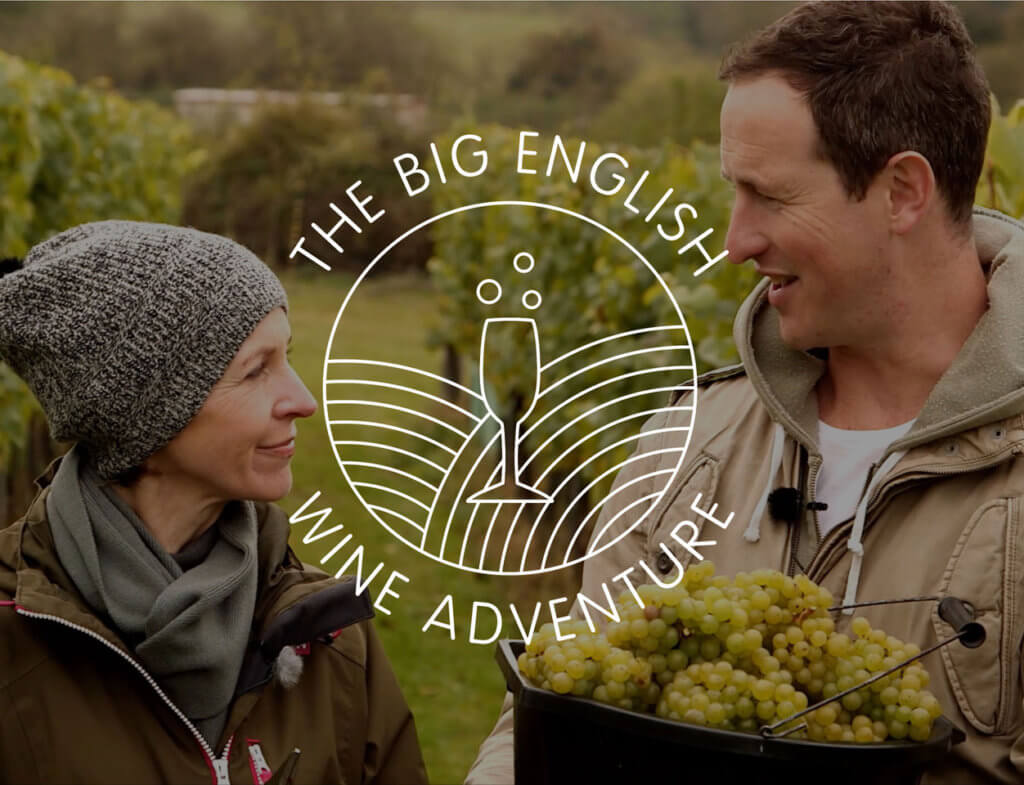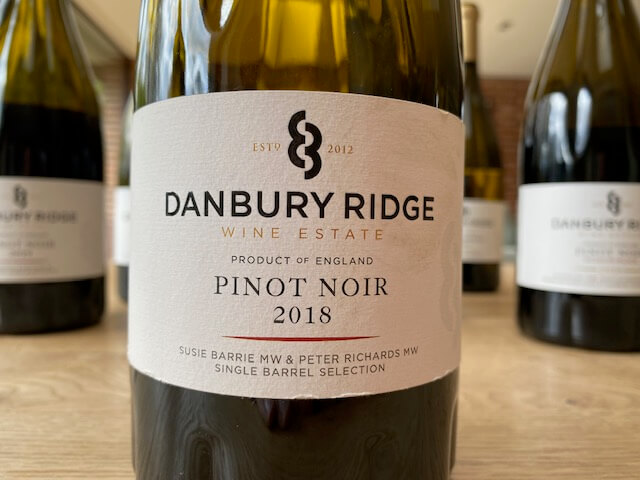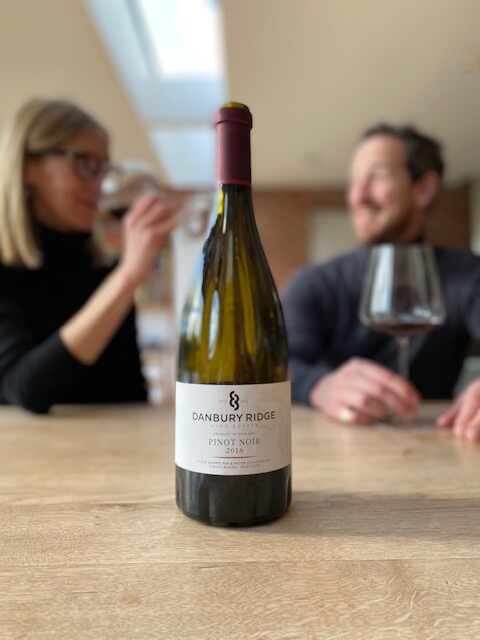- Becoming a Master of Wine Part 1
- Becoming a Master of Wine Part 2
- Big English Wine Adventure
- Bordeaux in 2021
- Build a Wine Collection at Home
- Dry Drinking
- Canada and Crisps
- Napa + wine on screen
- Glass Works
- Dreaming of a wine Christmas
- Burgundy in 2021 Part 1
- Burgundy in 2021 Part 2
- New Zealand Sauvignon Blanc
- Our Story, Part 1
- Our Story, Part 2
- Season Two Trailer
- Sommeliers – What Next?!
- Spread the Love – with Majestic Wine
- The Sam Neill EXCLUSIVE
- The Undeserved Hangover
- Wine can be a career?! (Re-run)
Summary
How do you fancy getting a name of your choosing on a wine label, benefitting a charity that’s close to your heart…and winning some delicious, unique English wine in the process?!
That’s exactly what’s up for grabs in this episode, in which we discuss our Big English Wine Adventure, chat with superstar UK winemakers Liam Idzikowski (Danbury Ridge) and Emma Rice (Hattingley Valley), get excited about Essex Pinot and Hampshire Meunier…and throw around some wine puns on the theme of The Simpsons. Now THAT’S entertainment.
We launched our Big English Wine Adventure back in 2016 – the year of Brexit, Andy Murray’s Wimbledon win, the Brazil Olympics, Boaty McBoat Face and the warmest year yet measured on earth. We wanted to do something fun and collaborative with English wine, something people could join in and be part of, not to mention raising money for a good cause.
Over the course of three, historic vintages in the UK (2016, 2017 and 2018), we teamed up with Hampshire producer Hattingley Valley and brand new Essex wine estate Danbury Ridge, to produce three unique wines: two markedly different styles of Hampshire sparkling and one very fine barrel of Essex Pinot Noir.
Now we need your help to find a charity to work with – as well as a name for our sparkling wines. Whoever submits the winning nomination will receive a beautifully presented and packaged full set of all three wines, worth around £100, plus a copy of our Essential Guide to English Wine. Deadline for nominations is midnight on Sunday 2nd May 2021. To nominate, or for more info, head over to our Big English Wine Adventure page.
The wines are set for release in late 2021 and demand is expected to be high, given the nature of the wines and the extremely limited quantities available. As a result, pre-registration is now open, via the web page as above. Don’t miss out!
Running Order
- Introduction to the Big English Wine Adventure: 0
- Blinders competition thanks and winners: 1.40
- The Simpsons wine mash up: 2.46
- Explaining the Big English Wine Adventure: 7.57
- How to enter our Big English Wine Adventure competition: 13.28
- Opening our Essex Pinot Noir for the first time: 17.41
- Interview with Liam Idzikowski of Danbury Ridge: 20.37
- Interview with Emma Rice of Hattingley Valley: 29.00
- Wrapping up: 38.18
Starring
- Liam Idzikowski (Danbury Ridge Wine Estate)
- Emma Rice (Hattingley Valley)
- Moe Szyslak (in absentia)
- Susie & Peter
Notes
- Liam does make a very glancing reference to Domaine de la Romanée-Conti when discussing our Pinot Noir. Just saying.
- And Emma lets slip that Hattingley didn’t produce any Blanc de Blancs in the frost-hit 2016 vintage…because they didn’t have enough Chardonnay. Which means our wine is the only Blanc de Blancs they made that vintage. Which makes us feel a bit guilty. But also a bit thrilled that’s it’s unique as a result. But feeling thrilled makes us feel even more guilty…
- Is Essex an easier place to grow Pinot than Oregon these days? It’s a thought that Liam puts out there…
Photos
Head over to our Big English Wine Adventure page to see all the photos associated with the project. But here are a couple in the meantime…



Liam Idzikowski transcript
Liam Idzikowski (LI): We saw the quality of the fruit from in and around the Crouch Valley. And Pinot Noir and Chardonnay was originally planted for sparkling but we were getting to ripeness levels well before the end of September for sparkling, and this was without even trying, we weren’t doing crop thinning, canopy management was more kind of more managed towards sparkling. Yeah, 2016 we made some Pinot and Chardonnay, did really well, this gave Mike Bunker, the owner of Danbury and his family, just the confidence they could do something special. So it kind of escalated from there. Mike doesn’t do anything in half measures. He said: right, let’s build a winery. Completely quality focused. But you have to make some of the best Chardonnay and Pinot Noir in the world.
Susie Barrie MW (SB): So by this stage you’re at Danbury Ridge, been employed by Mike. And actually Peter and I first visited Danbury Ridge back in early 2018, we were doing our wine tour of Essex. And then of course there was the incredible hot 2018 vintage. And that meant we couldn’t resist the opportunity to collaborate with you, to make an English red, Pinot Noir, from this kind of new winemaking frontier: Essex, Crouch Valley. How would you summarise the potential of Essex and in particular the Crouch estuary for fine wine?
LI: Well, it’s one of these ones…at the start of this project, for fine still wine: how often can we do this, out of 5 years, make really good Pinots and Chardonnays? 2 or 3 out of 5 years? It’s a question we continue to ask. I thought maybe we were doing this 10 years too early. But we were able to get to those ripeness levels in 2018, 2019 was same again, Pinots at good ripeness. 2020 PN and Ch ripeness out the roof. Flavours are there as well. This long growing season…that we seem to be getting…
SB: Do you think that’s particular to Essex?
LI: Yeah. It is. Some of the best sites in Kent can do it as well. But in Essex, we have a lot lower rainfall and we seem to have just edged over that balance of getting to that ripeness and then pushing it further. Touch wood, rot hasn’t been an issue. We seem to be able to hang the fruit out longer. You listen to winemakers in Oregon, and we’ve nearly got it easier here over the last few years than they have in Oregon, where rains can come down heavy and early, and the ripeness levels they’re getting might not even be quite as high as here.
SB: So going back to our wine, we’ve made just one barrel of Pinot Noir from 2018. Amazing vintage. We selected and blended the wine with you. What’s your take on it, how did we do?!
LI: What you guys did, it was brave. We ended up looking at the wines, what you’ve got is 18 months in new Francois Freres medium long extra fine 36 month seasoned oak. Top class oak. It’s what Domaine de la Romanee Conti uses! Quite punchy. It’s no corners cut. Quite traditional flavours and outlook. Tasting it from barrel, it always tasted amazing. It went into bottle: tasting it, it had structure, grip, finesse. But I was always looking: when’s it gonna come together. Still feels like it’s a baby! The potential on this is amazing.
SB: We were amazed with the structure of the wines, the weight (in a Pinot style weight, not too much). But for England to get that kind of colour, flavour. To take that much oak. We were amazed. We agree – that wine hasn’t reached its peak by any means. It’s gonna go on for a long time. If we can resist drinking it!
LI: Yeah, that’s the problem, you’re always tempted to crack a bottle open! To see where it’s going. Right now you’ve got some amazing flavours, and it’s integrating.
SB: What for you makes a great Pinot Noir?
LI: Pinot’s such a complex grape and the wines are so varied. So different to the likes of Cabernet Sauvignon. You know what that tastes like. Scoring and judging Cabs is so easy: they’re very straightforward. You can tick all the boxes. Pinot is different. There’s quite an array…for me, the first thing it needs to be is silky. It can’t be clunky. Needs acid, needs to have a vibrancy about it. Needs layers of fruit. And it needs the tertiary aromas as well. So the unoaked Pinots for me won’t ever have the complexity the oak brings. But yeah, they need to be fresh, tertiary, vibrancy, is the way I see Pinots.
SB: Liam, thank you!
LI: Thank you.
Emma Rice transcript
Emma Rice (ER): I’m still very excited to be involved in the industry, 12 years on. It’s a growing industry, it could be considered one of the final frontiers of winemaking, and it’s not just the growth in production but it’s the growth in sales and awareness around the world with consumers as well.
Peter Richards MW (PR): And what about quality?
ER: Quality is going from strength to strength as the winemakers become more experienced and learn from our mistakes. It is a steep learning curve, and I don’t think a winemaker in the country would say they haven’t made a few mistakes along the way. But the quality is growing, not just from the quality of the grapes but from the quality of the winemaking.
PR: Emma, you see fruit from all over, because you make wine for others, as well as for yourself. Where and how does Hampshire fit into the bigger sparkling wine picture, given that both the wines we’ve made with you are from Hampshire fruit?
ER: I would say at the moment Hampshire is very much focused on high quality sparkling wine. We make some still wines here, which is a new departure, but the fruit from those comes from the eastern counties, Kent and Essex, I haven’t yet seen fruit coming in from a Hampshire vineyard that I would consider to be ripe enough to make good quality still wine. But the sparkling wines, particularly those on the chalk vineyards here in Hampshire, are exceptional in terms of quality.
PR: What does Hampshire give you in terms of what you’re tasting in the fruit and the wines?
ER: I’d say a lot of the Hampshire fruit we get, tasting as juice and as young wines, when we’re doing the blending: a depth of flavour. We have this incredibly long growing season – so the Hampshire fruit is the last to come in here at Hattingley, so we’re getting the Kent fruit in September, most of the Hampshire fruit arrives end October. So you’ve got another 5-6 weeks of time for those grapes to grow and develop flavour, while still maintaining that high acidity and relatively low sugar level. That’s the key element – the slightly longer growing season.
PR: In both of our wines, we’ve used some oak-aged components. This can be controversial, especially for fizz. Some purists don’t like it. We love it, you use it. What’s your take on the use of oak generally in terms of fizz?
ER: I will confess, when I first started here back in 2010, I told Simon the owner that we had to get some barrels. He had no idea that wasn’t common in sparkling wine or generally accepted practice. But I had been working in California for a few years and fell in love with using barrels and older barrels, just the flavours you’d get – or, not the flavours as such but the textures from the older barrels. So I persuaded him to buy some barrels and then it became a signature part of what we do. So it’s nearly all old oak, very few new barrels come into the winery, we look for a texture and small oxidative fermentations with very high surface to volume lees ratio, the wine in contact with the dead yeast cells at the bottom of the barrel, gives us a richness and a depth of flavour you don’t get purely from stainless steel ferment. But you do have to be very careful how much oak you use in a sparkling blend. Because if you go overboard, when you add a bubble to the wine, it exaggerates any flavours you have. Which is why you generally want to start with a fairly neutral base wine going into the bottle because the bubble, ageing process will exaggerate any flavours in the wine. So you have to be careful – a judicious use of oak is what’s required with sparkling.
PR: Judicious indeed. I’m so glad we’re working with an expert like you on all of this, it’s well beyond our pay grade. Moving on, when we made our 2nd fizz, we got very excited by the potential of Meunier. What’s your take on Meunier as a variety in the UK?
ER: Well, don’t try it in Essex, doesn’t work. Kent reasonable. But it’s not the forte of the eastern counties. By far the very best Pinot Meunier wines we get in the winery are from Hampshire, grown on chalk. On paper it shouldn’t work but it does. Actually the very very best Meuniers we see are those we’ve put to barrel as well. So the combination of flavours is wonderful – you don’t get this from Chardonnay or Pinot Noir.
PR: Our sparkling wines with you came from the 2016/2017 vintages, how would you characterise those vintages, and any recollections apart from us getting in the way?
ER: Both of those vintages are indelibly marked in my brain as two of the hardest frost years we’ve ever had. So frost coming in April – 2106 was 27th April, 2017 was 26th April. Temperatures got down to -6 for 6-7 hours, which is very unusual. So those vintages were set back by that in terms of yield – much smaller yields. In turn, that led to a small crop, subsequently both those vintages were warm and benign after frost. So the vines were only trying to ripen a small crop, so the fruit was pretty nice and ripe when we got to it as the vines didn’t have much energy to expend on them. 2016 was harder than 17, 17 is turning into one of those vintages that’s turning into a nice surprise. We didn’t have high hopes for it but some of the wines from 2017 are what you might call a sleeper vintage, it wasn’t upfront and obviously a fantastic year. But in the bottle these wines are starting to develop some wonderful flavours. All very excited about them.
PR: So 2016 maybe more intensity to the wines than 2017? Or is it not that easy to say?
ER: to give you an example, what we did in 2016, normally when we make a range of wines here, we’ll pull out a selection of the best chardonnays to make a Blanc de blancs, which we did for you. Relatively small scale – fine. But if I’d done that in the wider winery, I’d have taken the heart of the Chardonnay out of the winery to make that wine, therefore I’d have compromised my Classic blend. Similarly if I’d done it for a rose, taking best Pinot Noir and Meunier, I wouldn’t have anything left to make a classic. So we made a very hard decision that year – we only made one wine in 2016 for us. So that’s a reflection of the frost and the limitations that then imposed on us in terms of volumes to work with in the winery. The quality was great, it’s just the volumes were just much smaller.
PR: so our 2016 wine, which is a Blanc de Blancs, is the only BdB you made that year?
ER: it is!
PR: now we feel really bad we’ve stolen that fruit from you! But it’s going to a good cause…Emma Rice, thank you very much indeed.
ER: Thank you
